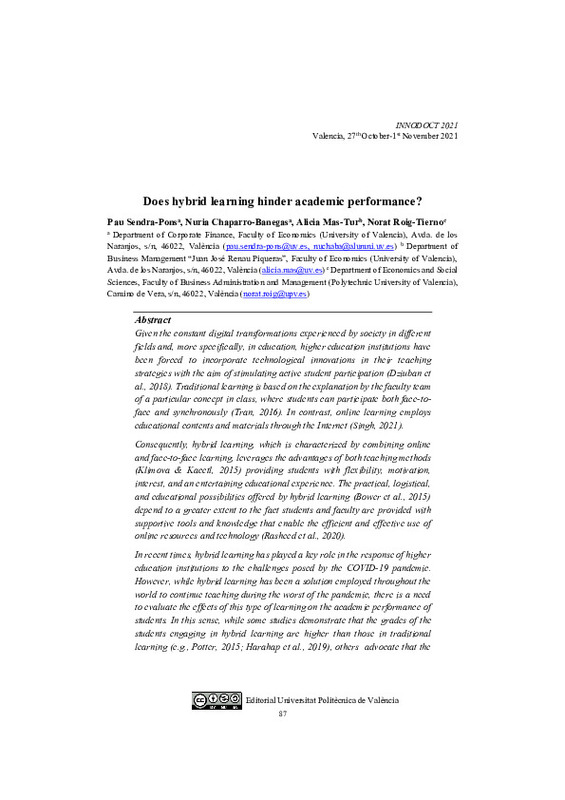|
Resumen:
|
[EN] Given the constant digital transformations experienced by society in different fields and, more specifically, in education, higher education institutions have been forced to incorporate technological innovations in ...[+]
[EN] Given the constant digital transformations experienced by society in different fields and, more specifically, in education, higher education institutions have been forced to incorporate technological innovations in their teaching strategies with the aim of stimulating active student participation (Dziuban et al., 2018). Traditional learning is based on the explanation by the faculty team of a particular concept in class, where students can participate both face-to-face and synchronously (Tran, 2016). In contrast, online learning employs educational contents and materials through the Internet (Singh, 2021). Consequently, hybrid learning, which is characterized by combining online and face-to-face learning, leverages the advantages of both teaching methods (Klimova & Kacetl, 2015) providing students with flexibility, motivation, interest, and an entertaining educational experience. The practical, logistical, and educational possibilities offered by hybrid learning (Bower et al., 2015) depend to a greater extent to the fact students and faculty are provided with supportive tools and knowledge that enable the efficient and effective use of online resources and technology (Rasheed et al., 2020). In recent times, hybrid learning has played a key role in the response of higher education institutions to the challenges posed by the COVID-19 pandemic. However, while hybrid learning has been a solution employed throughout the world to continue teaching during the worst of the pandemic, there is a need to evaluate the effects of this type of learning on the academic performance of students. In this sense, while some studies demonstrate that the grades of the students engaging in hybrid learning are higher than those in traditional learning (e.g., Potter, 2015; Harahap et al., 2019), others advocate that the differences in grades obtained by individuals of both groups are not statistically significant (e.g., Hsu y Hsieh, 2011; Halasa et al., 2020). The present study aims to analyze these effects by examining the differences in academic performance between a group of students with full face-to-face teaching and another with hybrid teaching. The objective is twofold: on the one hand, to determine whether hybrid learning meets the learning standards of traditional face-to-face teaching or whether it differs and in what sense it does so; on the other hand, to propose improvements in the hybrid learning model by introducing active learning methodologies that reinforce its pedagogical capacity. The methodology used consists of an ANOVA analysis to demonstrate if there are significant differences between the academic performance, measured by the grade of the course, of those students with hybrid learning [Group 1] and those who attended classes in person at all times [Group 2]. The following graph exhibits the mean and dispersion of grades for both groups of students. The mean of grades of individuals learning through traditional methods is higher compared to the mean of hybrid learning students. In this sense, this difference may be explained due to students’ distinct levels of motivation and attention span as they may adopt a passive behavior and may find problems in maintaining the interest during the hybrid learning process. The variability of grades also reflects this argument as Group 2 presents a more homogeneous performance than Group 1. Therefore, the results corroborate the existence of significant differences, with those students with hybrid learning presenting a lower performance. Table 1. Mean and dispersion of grades of hybrid learning students. Based on these results, we explore the challenges associated with non-face-toface learning in higher education and suggest pedagogical mechanisms aimed
at increasing student motivation and engagement with hybrid learning (see,
e.g., Sendra-Pons et al., 2020). This study not only has implications in the
context of the COVID-19 pandemic but also contributes to a better
understanding of a learning approach that seems to be taking root in higher
education institutions. However, the study, although informative, is limited by
the size of the sample, and it is necessary to corroborate the results.
[-]
|







